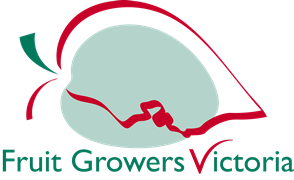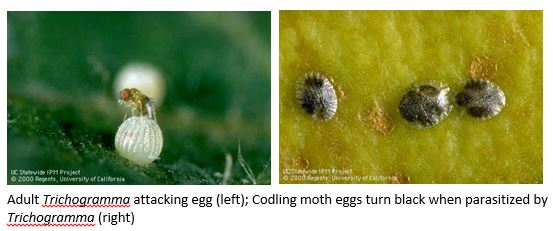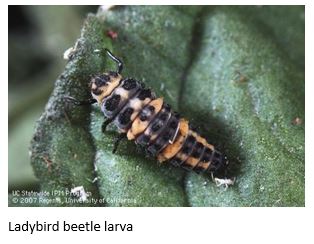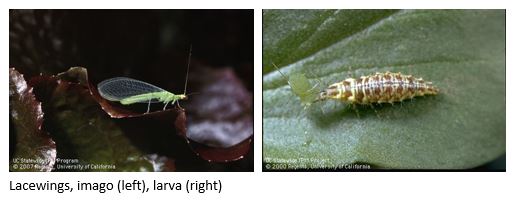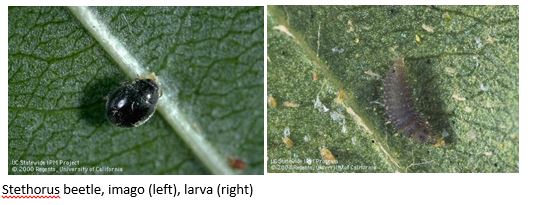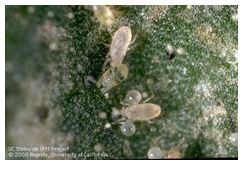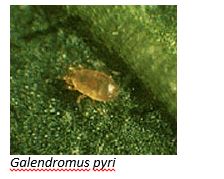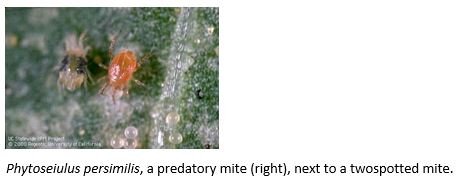Orchard Action
Beneficial Insects in Orchards
Apple orchards attract many kinds of insects that damage vegetation and fruit but these orchard pests have insect enemies of their own. Growers can provide habitat for these natural enemies, also known as beneficial insects, as part of an integrated pest management (IPM) strategy that reduces the need for pesticides.
In any crop, including apple and pear, several pest species can cause economic damage in a growing season. Considering all pests of apple trees, only 8-10 species may be of economic importance in any one year. In order to control these pests, a certain number of insecticide sprays must be applied during the season. If pests develop resistance to currently used insecticides, the number of spray applications will be much higher. Higher rates of pesticides, as well as "switching" of pesticides, may also be necessary to obtain acceptable economic control. Increased application of pesticides will affect the population of natural enemies allowing a resurgence of pest populations. Also, formerly innocuous species may assume pest status. There is, therefore, a need to develop truly integrated programs that will provide economic control of pests and at the same time allow natural enemies to survive.
Beneficial insects are thought of as, any insect that assists in pest control or pollination without harming humans, plants, or pets. Many organic growers will rely on beneficial insects as an alternative or complementary method of pest control rather than using pesticides. It should be noted that using pesticides can kill all kinds of insects in your orchard, both beneficial and harmful. Therefore, if you are using both pesticides and beneficial insects, you will need to be careful about the timing of releasing the insects, so that your pesticides do not kill them.
Examples of some beneficial insects:
Trichogramma wasps are one of the many varieties of beneficial parasitic wasps, ranging from tiny sizes no longer than one millimetre to wasps about an inch long. Parasitic wasps need to find a host to complete their metamorphosis. This will vary depending on the type of wasp, but many will use caterpillars, paralyse their host and then lay their eggs in or on them. When the egg hatches into a larva, the larva will feed on its host until it is ready to pupate, by then the host is either dead or moribund. Adult wasps mostly feed on nectar from flowering plants, so good pollinator plantings are the key for retention. Trichogramma are a very tiny wasp species that are an effective control for codling moth, a common pest for apples, pears and sometimes peaches and plums. Use codling moth pheromone traps to determine the best time for release.
Ladybird beetles are voracious predators of aphids, the soft bellied pests that suck the juice out of your plant leaves. Ladybugs will also eat mites and scales, other types of pests in your orchard. Unfortunately, ladybeetles rarely stay where they are released and in many cases aren’t sustainably harvested by suppliers. For this reason, purchase and release of ladybeetles is not recommended.
Lacewings are tiny green or black insects with clear, lacy wings that commonly fly around at dusk. Their larvae are known as “aphid lions”, but they also eat a wide variety of orchard pests including scales, mites, moth eggs, and small caterpillars. Australia’s largest group of lacewings are the antlions (around 250 species) which are particularly common in arid and semiarid areas. Adult and larval lacewings are mostly predators.
Stethorus beetle is a tiny (2-mm diameter), jet-black ladybird beetle. The larvae of this beetle has dull grey hairs, giving them a velvety appearance. Stethorus is a voracious feeder on many species of mites and is particularly effective against two-spotted mite. It is likely to suppress mite populations if it is present at high enough levels early in the cropping season.
PREDATORY MITES
Galendromus occidentalis (Western predatory mite)
Western predatory mites are about the size of two spotted spider mites, but lack spots, range in colour from cream to amber red (depending on what they just recently consumed), and are shinier and more pear-shaped than their prey. The prefer foods of western predatory mites and mites of all stages, including eggs but they also feed on pollen and other food.
Western predatory mite (top and bottom) and spider mite (center).
Galendromus pyri (formerly Typhlodromus pyri)
Adults are pear-shaped and slightly smaller than European red mite adults, which are their primary prey. G. pyri adults are white until they feed when they take on the red or brown coloration of their prey. The eggs are pear shaped, almost transparent but slightly larger than the round European red mite eggs. The larvae are also transparent and difficult to see without a microscope.
Phytoseiulus persimilis
Phytoseiulus spp. mites are about the size of two spotted spider mites but lack spots. They are orange in color and are shinier and more pear-shaped than their prey. The shiny oval eggs of Phytoseiulus persimilis are larger than spider mite eggs. In addition, predatory mites are much more active than pest mites, only stopping to feed. This predatory mite feeds exclusively on spider mites and consumes 2 or 3 adult females or several dozen eggs in a day. Phytoseiulus persimilis often needs to be reintroduced as it relies exclusively on mites for food and can eventually consume all available prey.
References:
- Elmer A.C. Hagley; 1996; Agriculture and Agri-Food Canada , Beneficial Insects in Tree Fruit Orchards in Southern Ontario
- 2004; Beneficial insect habitat in an apple orchard: Effects on pests (Research Brief #71)
- 2009; Integrated Pest Management for Australian Apples and Pears, The State of New South Wales, Industry & Investment NSW Apple and Pear Australia Limited.
- 2014: How to Manage Pests: Pest Management and Identification, Stateside Integrated Pest Management Program, University of California
Disclaimer: The information contained in this publication is based on knowledge and understanding at the time of writing. However, while all reasonable efforts have been made to ensure that this information is correct and current, the information covered is subject to change. Fruit Growers Victoria Limited does not assume responsibility and hereby disclaims any express or implied liability whatsoever to any party for any loss or damage caused by errors or omissions, whether these errors or omissions result from negligence, accident or any other cause.
